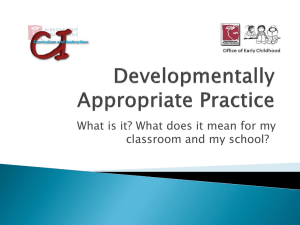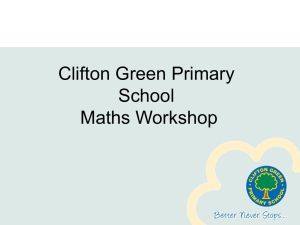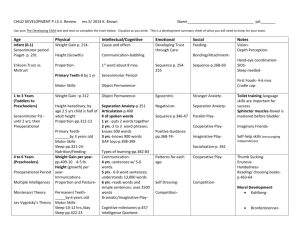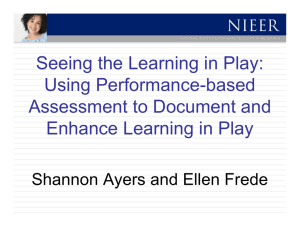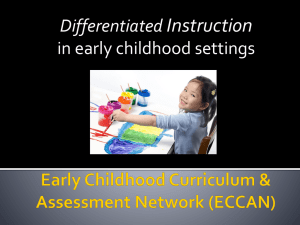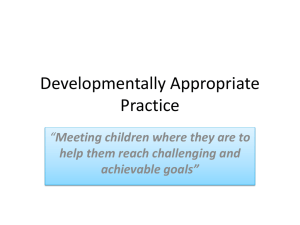The Importance of Play: Child Development Presentation
advertisement
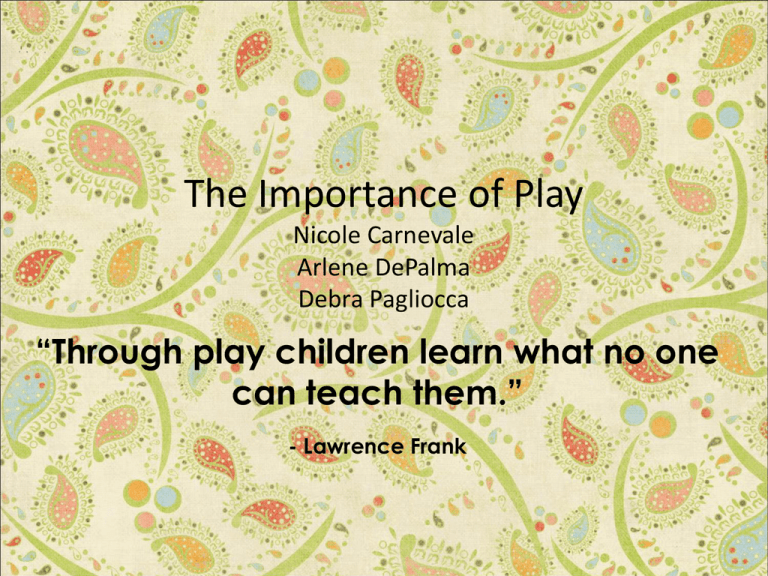
The Importance of Play Nicole Carnevale Arlene DePalma Debra Pagliocca “Through play children learn what no one can teach them.” - Lawrence Frank What is play? Types of Play • According to NAEYC • Four Types of Play: – Sensory/manipulative/object play/ and physical play – Constructive Play – Dramatic or Symbolic Play – Games with Rules Types of Play: • Sensory/manipulative/object play and physical play Types of Play: • Constructive Play Types of Play: • Dramatic or Symbolic Play Types of Play: • Games with rules Play: • Stimulates the senses • Develops fine and gross motor skills • Guides decision making • Enhances imagination • Promotes social skills and language Play: • Play is so important that the United Nations High Commissioner of Human Rights has recognized it as a right for every child. • During play children increase their knowledge and understanding of self, others, and the physical world around them. • Research on cognitive development and the brain show us that young children learn by constructing knowledge or wiring the brain in a more physical and interactive way, involving all of the senses. Play: • Toys are tools for the future. Children play with toys in an unstructured manner in order to create and actively engage in their physical environment to build knowledge. • Play contributes to all domains of development: cognitive, physical, and psychological. High Quality Play • In high quality play children are truly engaged • Complex play benefits children in developing executive functions • High level play leads to self-regulation • Studies have found that the quality of play is associated with social and linguistic competence. High Quality Play • • • • • • Consists of: Lengthy play periods Plenty of realistic props Unstructured, open-ended materials Interesting books Various role playing Observation of children’s interests and abilities Benefits of High Quality Play • • • • • • Longer interactions among children High levels of involvement More cooperation Support Self Regulation Strengthened ability to visualize situations Gain confidence through self control Gains in Social Emotional Activities • More empathy • Better ability to take on the perspective of others • Better control of impulsive actions • Better emotional and social adjustment • More innovation • More imaginativeness • Longer attention spans Gains in Cognitive- Creative Activities • • • • • Better verbalization Richer Vocabulary Better problem solving strategies Higher language comprehension Better ability to take on the perspective of another • Higher intellectual competence • Better peer cooperation Block Building • Block building offers one example of play’s value for mathematical learning. • As children build with blocks, they constantly accumulate experiences with the ways in which objects can be related. • Classic unit blocks and other construction materials such as connecting blocks give children entry into a world where objects have predictable similarities and relationships. Guiding Children’s Learning • Scaffolding – Lev Vygotsky • Teacher provides varying levels of support to help children stretch to learn new concepts, skills and understandings that are challenging but achievable. • As children work to master a new skill or acquire a new understanding the teacher pulls back on the level of support she offers. Using a Variety of Approaches • Teachers have a variety of strategies ready and remain flexible and observant: – Encourage – Give specific feedback – Model – Create add or challenge – Give a clue or hint – Provide information – Give directions Developmentally Appropriate Practice • DAP is an approach to early childhood education that means teachers meet individual children where they are and help them reach challenging but achievable goals that will support their development and learning. • When teachers make decisions they keep in mind: – Age appropriateness – Individual Appropriateness – Social and Cultural Appropriateness • Children are not machines. You cannot simply add more fuel and speed them up. They are governed by the laws of child development. • A five year old needs activities designed for how a five year old learns, not for how a ten year old learns. Supporting Healthy Play at Home • Give space and time for play • Offer simple play materials drawn from household objects • Spend time each day working with your hands at comprehensible tasks – raking leaves, baking – This inspires children’s play • Encourage outdoor adventures: run, climb, find secret places, use sticks, mud, twigs, etc. • A good toy is 10 percent toy and 90 percent child • Minimize time spent in adult organized activities and exposure to screen based media • "Creative play is like a spring that bubbles up from deep within a child. It is refreshing and enlivening. It is a natural part of the make-up of every healthy child. The child’s love of learning is intimately linked with a zest for play. Whether children are working on new physical skills, social relations, or cognitive content, they approach life with a playful spirit.“ - Joan Almon, Contemporary American educator Video • http://www.youtube.com/watch?v=ah4IHIqkcc&feature=youtube_gdata_player Resources • • • • • • • • • • Chopsticks and Counting Chips- Elena Bodrova and Deborah J. Leong Pretend Play Leads to Real Life Learning- Laura J. Cokler Developmentally Appropriate Practice and Play- National Association for the Education of Young People Block Building and Make- Believe for Every Child- Janis Strasser and Lisa Mufson Koeppel Teaching and Learning in the Kindergarten Year- Domenic F. Gullo Spotlight on Young Children and Play- Derry Koralek The Importance of Play- A conversation with Dr. Alison Gopnik Got Standards? Don’t Give Up on Engaged Learning- Judy Harris Helm First Steps Toward Teaching the Reggio Way- Joanne Hendrick http://usplaycoalition.clemson.edu
